Laptop Mag Verdict
The Lenovo Flex 5 is a strong performer with an attractive design, but its dim display and shallow keyboard brings it down.
Pros
- +
Attractive, two-tone design
- +
Solid performance
Cons
- -
Bland, dim display
- -
Shallow keyboard
Why you can trust Laptop Mag
Power and flexibility are often limited to premium devices, but the Flex 5 14-inch ($499.99 to start, $1,099.99 as tested) offers both. It's an affordable 2-in-1 with an optional Core i7 CPU and Nvidia 940MX GPU in an attractive, two-toned package. But with affordability comes some cuts, and despite its looks and power, the Flex 5 doesn't feel as good to use as its competitors. Its shallow keyboard and dim screen are also turnoffs, but you'll save money over similarly specked competitors.
Design
The Flex 5 's two-toned design is simple but eye-catching. The plastic lid is black with Lenovo's logo in silver in the top left corner. Opening the notebook reveals a gunmetal gray aluminum deck with an island-style keyboard, as well as a 14-inch, 1080p touch-screen display.
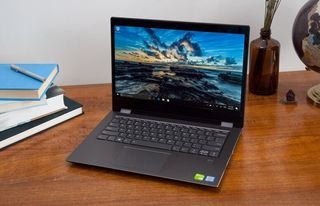
At 4.1 pounds and 12.9 x 9 x 0.8 inches, the Flex 5 is on the heavy side. While the 15-inch HP Spectre x360 (14 x 8.9 x 0.7 inches) is heavier at 4.4 pounds, the Lenovo Yoga 910 (12.7 x 8.8 x 0.56 inches) and Acer Spin 7 (12.8 x 9 x 0.4 inches) are lighter at 3 pounds and 2.9 pounds, respectively.
The Flex 5 has a pretty standard set of ports along its sides. On the left are an HDMI output, a USB 3.0 port, a USB Type-C port and a headphone jack. On the right side you'll find the SD card slot, a USB 3.0 port and a Kensington lock slot.

Because it's a convertible 2-in-1, the Flex 5 can be used as a laptop, tablet, display (with the keyboard folded back) or in tent mode (an upside-down "V").
Display
The Flex 5's 14-inch, 1920 x 1080 touch display is darker than competitors and offers bland colors. When I watched an FHD trailer for "Justice League," a lot of details were lost in dark shadows. When Wonder Woman talked to Bruce Wayne in the Batcave, I couldn't even see the left side of the billionaire playboy's mouth. The Flash's normally red suit was just a tad on the burgundy side, but the red and blue lights attached to Cyborg appeared color accurate.

The screen covers just 74 percent of the sRGB color gamut, far below the thin-and-light average (104 percent) and less vivid than the Yoga 910 (98 percent), the Spin 7 (113 percent) and the Spectre x360 (113 percent).
MORE: Longest Battery Life Laptops
At 242 nits of average brightness, the Flex's display is dim, falling short of the 262-nit average. The Spectre reached 255 nits, while the Spin 7 measured 264 nits. The Yoga was the most luminous at 292 nits.
Keyboard and Touchpad
The Flex 5's keyboard doesn't offer as much feedback as I like. With just 1.3 millimeters of travel (we prefer at least 1.5mm) and 72 grams of required force to press, it wasn't clicky or deep. I didn't bottom out, but it felt a bit soft. On the 10fastfingers.com, I typed at 110 words per minute, within my average range, but my error rate doubled from 2 to 4 percent.
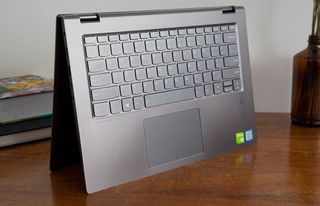
The 4.1 x 2.7-inch touchpad is smooth, accurate and responsive to Windows 10 gestures, like tapping three fingers to summon Cortana and two-finger scrolling. It's a bit shallow for my liking, but it's something I could get used to.
Audio
The Flex's speakers are a mixed bag. The laptop was just loud enough to fill the room with sound and get my toes tapping during Paramore's "Ain't It Fun," and the vocals were very clear. The guitars and drums were easy to make out but didn't have the same level of prominence. The bass, however, was nowhere to be found.
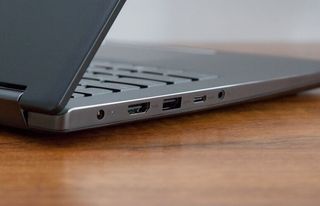
The Dolby Audio app offers presets for different media, like movies, music and games. I found the default (music) to be the most balanced.
Performance
With a 2.7-GHz Intel Core i7-7500U CPU, 16GB of RAM, a 1TB, 5,400 HDD, 128GB SSD and a Nvidia 940MX GPU with 2GB of VRAM, it's no surprise that the Flex 5 can handle everyday usage with aplomb. I had 30 tabs open in Google Chrome (including one streaming a 1080p episode of "The Daily Show with Trevor Noah" from YouTube) without a single hiccup.

But on the Geekbench 4 overall performance test, it notched a score of 7,748, falling below the thin-and-light average (9,096) and the Spectre x360 (8,017, Core i7-7500U) while tying the Yoga 910 (7,748, Core i5-7500U). Only the Spin 7, with its Core i7-7Y75 CPU, performed worse, with 5,777.
It took the Flex 5 27 seconds to duplicate 4.97GB of files. That's an effective transfer rate of 188.5 megabytes per second. While that's speedier than the Spin 7 (124.1MBps), the Yoga (194.7Mbps) and the Spectre x360 (282.1MBps) were much quicker.
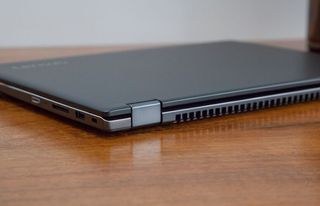
The Flex 5 paired 20,000 names and addresses in 3 minutes and 38 seconds on our OpenOffice spreadsheet test. The average is 4:15, and again, the Spin 7 was slower (4:37). But the Yoga 910 and the HP Spectre x360, tied at 3:34, were faster.
The 940MX GPU isn't the most powerful graphics card, and you won't be playing games like Rise of the Tomb Raider or PlayerUnknown's Battlegrounds with it, but you might get some faster performance in Photoshop. It notched a score of 105,373 on the 3DMark Ice Storm Unlimited benchmark, easily surpassing the average (78,675), the Spin 7 (48,146, Intel HD Graphics 615) and the Yoga 910 (77,093, Intel HD Graphics 620). The HP Spectre, which has the same 940MX with 2GB of VRAM, scored 93,759.
Battery Life
The Flex 5 should have no trouble giving you a day's worth of performance at work or school. It lasted 8 hours and 15 minutes on the Laptop Mag Battery Test, which continuously browses the web over Wi-Fi. The average is a little longer (8:20), and both the Spectre x360 (8:36) and Yoga 910 (a whopping 10:36) offered more endurance. The Spin 7 fell behind at just 6:53.
Webcam

The 720p webcam on the Flex 5 is color accurate and quite detailed. My bright red shirt appeared on screen as it does in real life, and I could even make out some individual hairs. The lights behind me were a bit blown out, though, creating distracting lines around my headphones.
Heat
In our testing, the Flex 5 met but did not exceed our 95-degree comfort threshold. After streaming 15 minutes of HD video from YouTube, the Flex measured 96 degrees Fahrenheit, the center of the keyboard reached 86 degrees and the touchpad was 79 degrees.
Software and Warranty
The Flex 5 continues Lenovo's tradition of including minimal software, which is mostly useful. It includes the Companion app for keeping your system updated and running diagnostics, as well as the settings app with options for the webcam and networking.
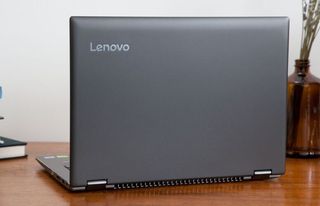
The rest is just the same junk you find in any Windows 10 installation: Drawboard PDF, Candy Crush Soda Saga, Bubble Witch 3 Saga, March of Empires, Minecraft: Windows 10 Edition, Twitter and AutoDesk SketchBook.
Lenovo sells the Flex 5 with a one-year warranty. See how the company performed in our Tech Support Showdown and Best and Worst Brands report.
Configurations
The Lenovo Flex 5 we reviewed cost $1,099.99 with a 2.7-GHz Intel Core i7 CPU, 16GB of RAM, 1TB, 5,400-rpm HDD, 128GB PCIe SSD, a Nvidia GeForce 940MX with 2GB of VRAM and a 1080p display. You can get a version with almost identical specs, except no SSD or discrete GPU, for $879.99.
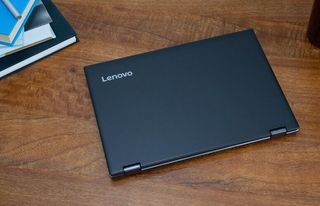
The base model is $499.99, and comes with a Core i3-7100U CPU, 1366 x 768 display, 4GB of RAM, 500GB, 5,400-rpm HDD and no discrete GPU.
A model with a Core i5-7200U CPU, 1080p display, 8GB of RAM and 1TB, 5,400-rpm HDD is $699.99. Again, you only get integrated graphics with this model.
Bottom Line
The 14-inch Lenovo Flex 5 is a powerful, attractive 2-in-1 that falls short with a dim display and a shallow keyboard. It had the potential to be great, but those cut corners make the Flex 5 only good at best.
If you've got a bit more money to spend, the HP Spectre x360 (starting at $1,279.99) is the better way to go. Its starting configuration offers a 256GB SSD and has a brilliant 4K display. It has longer battery life and a beautiful, premium design. If you want something closer in price or want to stick with Lenovo, the $1,200 Yoga 910 is a better choice. It's more portable, has over 2 hours more battery life, a great keyboard and a gorgeous display.
But if you want a 2-in-1 on a budget and don't mind boosting your brightness to the max, the Flex 5 can be a powerful contender for the money, as long as you can put up with its drawbacks.
Credit: Shaun Lucas/ Laptop Mag
Lenovo Flex 5 (14-inch) Specs
| Bluetooth | Bluetooth 4.1 |
| Brand | Lenovo |
| CPU | 2.7-GHz Intel Core i7-7500U CPU |
| Card Slots | SD memory reader |
| Company Website | lenovo.com |
| Display Size | 14 |
| Graphics Card | Nvidia GeForce 940MX 2GB / Intel HD Graphics 620 |
| Hard Drive Size | 1 TB |
| Hard Drive Speed | 5,400rpm |
| Hard Drive Type | SATA Hard Drive |
| Highest Available Resolution | 1920 x 1080 |
| Native Resolution | 1920x1080 |
| Operating System | Windows 10 Home |
| Ports (excluding USB) | HDMI, USB 3.0, Headphone/Mic, SD card slot, USB Type-C |
| RAM | 16GB |
| Secondary Hard Drive Size | 128 GB |
| Secondary Hard Drive Type | PCIe m.2 SSD |
| Size | 12.9 x 9 x 0.8 inches |
| Touchpad Size | 4.1 x 2.7 inches |
| USB Ports | 3 |
| Video Memory | 2GB |
| Warranty/Support | One year |
| Weight | 4.06 pounds |
| Wi-Fi | 802.11ac |
| Wi-Fi Model | 2x2 |
